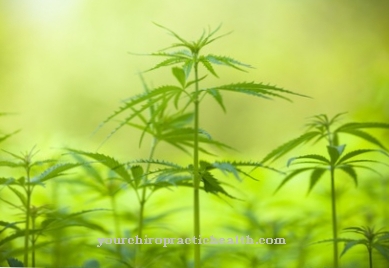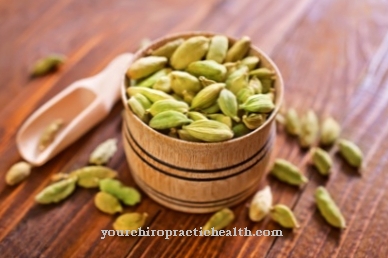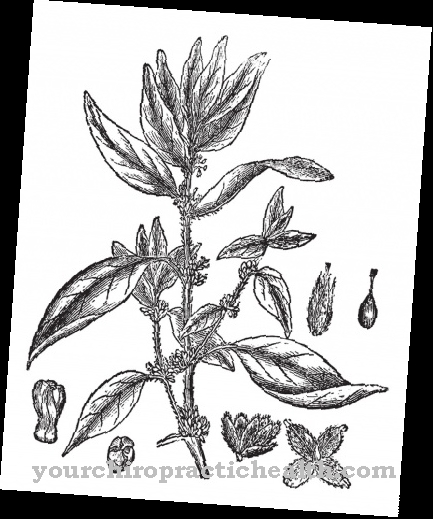Kalisaya represents one of 23 species of the Cinchona plant genus (cinchona trees). It was originally only native to South America and was used there by the natives as a medicinal plant against malaria. Today cinchona trees only play a major role in quinine extraction.
Occurrence & cultivation of the Kalisaya

The pink-red flowers also grow on stems and each form five petals. Originally the cinchona bark trees were only common in South America. In the course of the colonization of the continents, however, they were also cultivated in Central Africa, Indonesia and India due to their medicinal properties against malaria and their antipyretic properties. The name cinchona bark has nothing to do with China, but was derived from the name kina-kina from the Quechua language.
That means something like bark of the bark there. Cinchona calisaya is not considered the official cinchona bark. This is called Chinchona officinalis. However, a large part of the official cinchona bark is obtained from Kalisaya. After the Second World War, the importance of cinchona bark declined sharply because synthetic agents were developed to combat malaria and fever. The bark of the Kalisaya is sometimes still used in stomach tea mixtures. It still has a certain significance in homeopathy.
Effect & application
The main active ingredient of all cinchona trees and thus also the Kalisaya is quinine. In addition to quinine, it also contains the active ingredients quinidine and cinchonidine. It was found, however, that not all species of the genus of cinchona trees have these active ingredients in the same amount. The content of the active ingredients in Cinchona calisaya proved to be insufficient to ensure economical isolation.
Mainly the species Cinchona ledgeriana was used to extract quinine until after the Second World War. After that, quinine lost its importance in favor of synthetically produced active ingredients against malaria such as chloroquine and primaquine. However, it has been shown today that the synthetic active ingredients can develop resistance to the malaria pathogens. The development of resistance from quinine is very low.
Malaria is caused by so-called schizonts. The schizont represents a developmental stage of plasmodia. Quinine has a killing effect on schizonts without developing resistance. Due to the increasing development of resistance through the use of synthetic active ingredients, quinine is now being used again more often for the treatment of malaria. It is still obtained from the bark of cinchona trees. Quinine inhibits the enzyme hempolymerase produced by plasmodia.
Hempolymerase is responsible for the life-threatening breakdown of hemoglobin in the blood. Due to the hempolymerase inhibition, the malaria pathogens are damaged by quinine. The action of quinine is based on its binding to proteins. Since other important proteins are also blocked, side effects of a quinine overdose occur. However, quinine is almost completely metabolized in the liver and then excreted renally.
Another active ingredient in Kalisaya and all other cinchona trees is quinidine. Its effect is based on the fact that it binds to open sodium channels, reduces the conductivity of potassium and inhibits the calcium channels of the heart muscles. Therefore, it is used as an antiarrhythmic for atrial fibrillation. The cinchona bark, including the kalisaya, is the only source of quinine today. However, due to its natural use, it no longer plays a role in herbal medicine.
Importance for health, treatment & prevention
As already mentioned, cinchona bark, including Kalisaya, was used in South America as the most important medicinal plant against malaria and fever. In the meantime, the development of other anti-malarial drugs has reduced their importance as medicinal plants. However, the active ingredient quinine, which is obtained from cinchona bark, is gaining more medical importance again. Kalisaya still plays an important role in homeopathy.
As a medicinal plant, it was mainly used for fever. Its anti-malarial effect was recognized early on. It also has an antispasmodic and pain reliever. It is also used for stomach problems, calf cramps and muscle cramps. Cinchona bark trees are of particular importance for the production of quinine and quinidine. Quinine is again being used more often in the fight against malaria, especially tropical malaria.
It also proves to be effective against flu-like infections due to its numbing and fever-reducing properties. A special area of application is its use in the so-called babesiosis. This is an infection with unicellular spore animals that are transmitted to the organism via ticks. Babesiosis manifests itself through flu-like symptoms. Treatment is by oral administration of quinine and clindamycin.
However, quinine can also cause side effects such as nausea, vomiting, diarrhea, abdominal pain, allergic reactions, toxic effects on the nervous system or cardiac arrhythmias. Cinchona bark preparations produce the same effects if overdosed. Contraindications for quinine are tinnitus, disorders of the optic nerves or pregnancy.
Excessive doses can lead to dizziness, drowsiness, vomiting, ringing in the ears, addiction to sleep, tremors and restlessness. This is a so-called quinine intoxication, which can also be caused by excessive administration of cinchona bark. In some people, even the slightest contact with Kalisaya or other cinchona trees causes intoxication symptoms or hives, edema and skin bleeding.

























.jpg)


